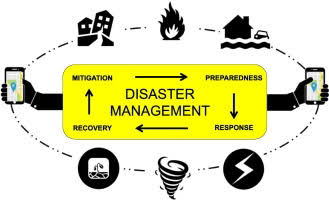DISASTER MANAGEMENT IN INDIA
Natural disasters or human-made disasters can happen anytime. They interrupt the normal functioning of the environment and society. To bring it under immediate control, there is a need for emergency intervention to bring things under management. The effects of the disasters must be put to ease to control the situation and the properties from getting destroyed. Disaster management is a multi-faceted program which involves saving of lives of people, animals and properties during the occurrence of a natural disaster or a disaster caused due to manmade activities. It deals with different kinds of disasters like drought, earthquakes, floods, hurricanes and landslides.
In India, the Disaster Management Act, 2005 is the legislation which provides a framework for disaster management and mitigation. The Act calls for the establishment of National Disaster Management Authority (NDMA), which is the apex statutory body for disaster management in India with the Prime Minister of India as the Chairperson. The NDMA is responsible for "laying down the policies, plans and guidelines for disaster management" and to ensure "timely and effective response to disaster". Under section 6 of the Act it is responsible for laying "down guidelines to be followed by the State Authorities in drawing up the State Plans".
HISTORY:
In recognition of the importance of Disaster Management as a national priority, the Government of India set up a High-Powered Committee (HPC) in August 1999 and a National Committee after the Gujarat earthquake (2001), for making recommendations on the preparation of Disaster Management plans and suggesting effective mitigation mechanisms. The Tenth Five-Year Plan document also had, for the first time, a detailed chapter on Disaster Management. The Twelfth Finance Commission was also mandated to review the financial arrangements for Disaster Management. Therefore, on 23 December 2005, the Government of India enacted the Disaster Management Act.
SUCCESS IN DISASTER MANAGEMENT:
NDMA runs intensive earthquake and extreme weather events awareness campaigns and provides guidelines regarding natural and man-made disasters. It has also released Guidelines on School Safety, Hospital Safety and Minimum Standards for Shelter, Food, Water, Sanitation and Medical Cover in Relief Camps. The Authority worked closely with the States in mitigating the impact of Heat Wave and the number of casualties came down drastically.
In the recent times, India has faced a series of Cyclones like Fani, Visarga, Amphan, etc. and other Calamities. The United Nations Office for Disaster Risk Deduction (UNISDR) and other organizations have hailed Government and volunteer efforts that have ensured the levels of destruction to keep minimum. There has been significant reduction in mortality rate from the loss of over 10000 lives in 1999 during Super Cyclone in Odisha to a mortality of 16 in 2019 during cyclone Fani.
SHORTCOMINGS AND CHALLENGES:
A series of questions were raised about the role of NDMA during Uttarakhand Flooding in 2013, where it failed to timely inform people about the flash floods and landslides. The post disaster relief response had been equally poor. Experts blamed the poor planning of NDMA that lead to unfinished projects for flood and landslide mitigation. A CAG report noted that there were delays in completion of projects under the flood management programmes. It noted the projects were not taken up in an integrated manner and blamed NDMA for institutional failures for poor flood management. Devastations during Kerala Floods in 2018 and Chennai Floods in 2015 were eye-opening for the institutions regarding preparedness for the disaster situation. Also, the NDRF personnel lack sufficient training, equipment, facilities and residential accommodation to tackle the crisis situation properly.
Thus, even though Disaster Management in India has been improved as compared to the previous years and instances, with the passing time, it needs to be more robust and prepared. Given the rapid changes in climate and nature, the time ahead requires more serious attention and better preparedness for preventing as well as mitigating disaster, so that human life in World’s 2nd most populated country gets saved.
PUSHPAM SINGH




Comments
Post a Comment